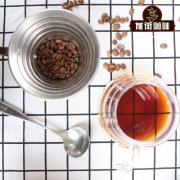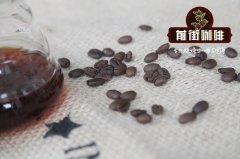What are the ingredients of coffee? The caffeine content of coffee beans caffeine in coffee

Professional coffee knowledge exchange more coffee bean information please follow the coffee workshop (Wechat official account cafe_style)
Why do some coffees have the sour taste of plums? Some even taste like fruit vinegar.
Why do some beans look so shiny? Is it because it has been kept for a long time?
Why does some coffee taste so bitter?
And caffeine. . . . Is it true that the longer the coffee is roasted, the less caffeine is?
If you want to understand these questions, you must first understand the composition of coffee and coffee roasting!
Our common brown coffee beans, with a little aroma, are ripe beans of coffee, which have been roasted.
Unbaked coffee is called raw beans or mung beans (green bean). In addition to water, other ingredients of raw beans are carbohydrates (also known as carbohydrates), proteins, lipids, organic acids, minerals, trigonelline, and other acidic substances (mainly chlorogenic acid).
What does the raw bean taste like? If someone asks this question, he can probably only answer: "the taste of raw beans is the taste of raw beans. When you taste it, this is the taste of raw beans." "
The taste of raw beans is very different from that of cooked beans, so someone once said, "80% of the taste of coffee is determined by raw beans, while the other 20% depends on roasting." "
A successful coffee shop, the people who buy and bake coffee beans behind the scenes must have skilled skills and a keen sense of taste. Unlike wine tasting, it is a group of people who make the final decision; in the coffee industry, there is only one person, a real "baker" who is not involved in planting, harvesting, or processing. Everything else has to be done on his own: buying beans, deciding to make a combination of coffee, and judging the time and temperature of baking by a sixth sense.
A clumsy, distracted roaster may turn the company's investment into smoke, while a smart one can turn second-rate coffee beans into even mixed coffee, while high-quality beans are even more unforgettable.
Hot freshly baked toast, crispy French fries, and even the aroma of barbecue with onions. Wait, wait, wait. The same is true of roasting coffee beans. In the process of high temperature heating, starting the "caramelization reaction" and "Mena reaction" presents a unique good taste.
Carbohydrates account for about half of the dry matter, and sucrose is thought to be related to the flavor of coffee. The higher the sucrose content, the better the coffee. This can be confirmed by the fact that the flavor of Arabica is much better than that of Robusta (the amount of sucrose in Arabica is about twice that of Robsta). The sugar content of coffee is mainly stored in the form of sucrose, and the concentration of sucrose is the highest when the coffee fruit is ripe. Studies have found that defective coffee beans or semi-unripe beans also have low sucrose content.
When beans are in dire straits, sucrose in the body is involved in the caramelization reaction. Sucrose dehydration releases moisture and carbon dioxide, releasing hundreds of aromatic substances, including cream sugar (diacetyl, Diacatyl), caramel flavor. Caramel accounts for about 17% of the weight of coffee cooked beans, bitter taste with sweet, is an important taste of coffee.
Not only that, sucrose also contributes to improving the sour flavor of coffee. Acetic acid, lactic acid, glycolic acid and formic acid, which belong to the family of fatty acids, are all aromatic acids created by sucrose during baking. The concentration of these acids reaches the maximum when they are baked lightly to moderately.
Sucrose relatives, such as glucose, fructose, lactose, maltose and other reducing sugars, encounter amino acids and produce another type of chemical reaction, called the "Mena reaction", which will undergo a series of complex degradation and polymerization to produce aroma. More than a hundred aromatic compounds have been born, including glycosylamine (Glycosylamine), glycolaldehyde (Furfural) and melanin (the pigment of cooked coffee beans).
Chlorogenic acid (Chlorogenic acid) is the main organic acid in mung bean. In the process of heating, part of chlorogenic acid will be converted into bitter chlorogenic acid lactone (Chlorogenic acid lactone).
The other part of chlorogenic acid will be degraded into quinic acid (quinic acid) and caffeic acid (caffeic acid).
Some people think that quinic acid is one of the sources of bitterness of deep-baked beans, but the American boutique association believes that quinic acid is water-soluble, which not only increases the thickness of alcohol, but also increases the complexity and brightness of coffee. Caffeic acid is slightly astringent.
In addition to chlorogenic acid, raw coffee beans also contain citric acid and malic acid, but these two acids are considered "sharp acid" and decrease with the baking process.
* chlorogenic acid, quinic acid and caffeic acid are all antioxidants, so coffee has antioxidant function when it is cooked fresh.
Trigonelline has a bitter taste, and during baking, trigonelline is degraded into many aromatic substances, including nicotinic acid (commonly known as vitamin B3) and other flavor molecules with caramel and mushroom flavor. The more cucurbitine degraded by roasting, the better the taste of coffee and the more nicotinic acid is produced.
Lipids
The amount of fat will affect the taste of coffee. Many substances that add flavor to coffee are fat-soluble, that is, they are dissolved in oil. Coffee has a lot of fat and tastes extra round. Unlike other substances, after baking, beans have less carbohydrates and proteins, but more lipids. Arabica tastes better than Robusta, thanks to the fat.
High-quality medium-roasted coffee can sometimes taste the unique sour and sweet taste of the fruit.
Suppose we are all mung beans, and in the hard green body, water accounts for only 12% of the small body.
Many mung beans are thrown into the hot oven, and for the reason of average heating, they are not only roasted by the fire, but also endure constantly turning. When the water in the body reaches 100 degrees Celsius, it will evaporate. at the same time, carbohydrates are decomposed by heat, producing carbon dioxide. These powerful air currents flow through the body, more and more, and finally have nowhere to go. I had to rush out of the body with a burst. That's when you hear the sound of popcorn. Bang! Bang! Bang! Is not lively, immediately aroma overflows, this process is called "one explosion". At this time it is no longer mung beans, but brown beans.
Since there is an explosion, it means that there will be a second explosion. Before the second explosion, we define the baking degree as medium baking. Medium roasted beans can highlight the "regional flavor" of coffee producing areas, reduce the processing of baking flavor, and drink out the delicate fragrance and sour of beans themselves. The concentration of vanillic acid produced by the combination of sucrose reaches the maximum when it is roasted from shallow to medium baking.
When the beans continue to be heated and enter the second explosion, the second explosion begins for 20-40 seconds, and the smell of coke begins to be smelled, and the oil appears on the surface of the bean body. It's medium and deep baking.
When the sound of the second explosion reaches the maximum density, the glossy light is more obvious, which is also for deep baking.
At this time, the acetic acid, lactic acid, glycolic acid and formic acid produced by sucrose decay rapidly after being baked in medium and deep depth. (acidity decreases)
Not only that, chlorogenic acid is first degraded into bitter chlorogenic acid lactones, and if the beans are not turned off and continue to heat the beans, chlorogenic acid lactones will be degraded into more bitter phenyl lindane (Phenylindanes), which is why the heavier the baking, the greater the bitterness. (bitterness increases)
It's not over yet. There are only 30% citric acid and malic acid left in deep-roasted coffee. (acidity continues to decrease)
However, deep baking is also good.
Fenugreek alkaloid part. Trigonelline has a bitter taste. With the extension of baking time, the more trigonelline was degraded, the more nicotinic acid was obtained. The study found that deep-roasted beans contain 4-5 mg of nicotinic acid per 10 grams, while moderately roasted coffee beans contain less nicotinic acid, only 0.8-1.5 mg per 10 grams. (more nicotinic acid)
Medium baking: bright sour fruit, heavy sweetness, light bitterness and obvious layers of taste, as long as you use the beans well.
Deep baking: low and thick, no significant sour taste, but the throat is sweet, good beans are still the premise.
Bean oil production: shallow baking, medium baking will not appear glossy, medium and deep baking begins to point out oil, deep baking oil is obvious.
Many people often criticize deep-baked beans to be useless, thinking that the well-baked deep-baked beans are designed to cover up the bad smell of rotten beans by carbonization (such as stinky grain fermentation, metal or turbid soil smell of thick and strong beans). Because most operators are unwilling to spend a lot of money on good beans and are used to deep baking to remove the bad taste of rotten beans, they often only drink the bitter taste of the throat, or add a lot of water to dilute it. The American coffee sold in a convenience store is as light as water.
Caffeine issue
The ambient temperature required for the first explosion of coffee beans is about 170-205 degrees Celsius, the temperature required for the second explosion is about 203-220 degrees Celsius, and the melting point of caffeine is 237 degrees Celsius, so as long as the roasting temperature is below 237 degrees Celsius, caffeine will not be reduced, so the same batch of beans, medium-roasted or deep-roasted coffee contains the same amount of caffeine.
Some people may say, "I drink deep-roasted coffee more prone to insomnia."
The reason is that deep-baked beans take longer baking time, lose more moisture, and beans are lighter, so when weighing 10 grams of beans, deep-baked beans need more beans, and of course the caffeine content is higher.
Professional coffee knowledge exchange more coffee bean information please follow the coffee workshop (Wechat official account cafe_style)
Important Notice :
前街咖啡 FrontStreet Coffee has moved to new addredd:
FrontStreet Coffee Address: 315,Donghua East Road,GuangZhou
Tel:020 38364473
- Prev

Coffee fans must know the coffee utensils used to make coffee in English.
Professional coffee knowledge exchange more coffee bean information please follow the coffee workshop (Wechat official account cafe_style) there are hundreds of coffee brewing utensils on the market, but it is not clear which coffee set tastes good, because everyone has different tastes, even if they are the same coffee beans, sour and bitter brewed with the same coffee utensils at the same time.
- Next

Why is coffee sour? What's in the coffee? What is chlorogenic acid?
Professional coffee knowledge exchange More coffee bean information Please pay attention to coffee workshop (Weixin Official Accounts cafe_style) Chlorogenic acid is an antioxidant Antioxidant effects, which reduce cell damage from free radicals, are thought to be associated with chronic disease or cancer prevention. The chlorogenic acid content varied with the degree of baking, with light baking being the highest, medium baking the second, and heavy baking the third
Related
- Beginners will see the "Coffee pull flower" guide!
- What is the difference between ice blog purified milk and ordinary milk coffee?
- Why is the Philippines the largest producer of crops in Liberia?
- For coffee extraction, should the fine powder be retained?
- How does extracted espresso fill pressed powder? How much strength does it take to press the powder?
- How to make jasmine cold extract coffee? Is the jasmine + latte good?
- Will this little toy really make the coffee taste better? How does Lily Drip affect coffee extraction?
- Will the action of slapping the filter cup also affect coffee extraction?
- What's the difference between powder-to-water ratio and powder-to-liquid ratio?
- What is the Ethiopian local species? What does it have to do with Heirloom native species?

